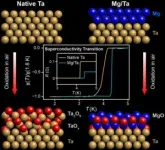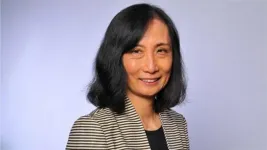(Press-News.org) Gastrointestinal cancers (GCs) are among the most common forms of cancer and account for as much as one-third of all cancer deaths worldwide. Early diagnosis is an effective way of reducing the mortality associated with GCs, and endoscopic screening has proved to be an excellent approach for detecting potentially malignant tumors.
To extend the benefits of screening programs to as many people as possible, the imaging systems used should be inexpensive to manufacture and operate, yet accurate enough to achieve low miss rates. To achieve this, scientists have been experimenting with different imaging modalities.
Among them, spatial frequency domain imaging (SFDI) is a promising technique for differentiating between healthy and malignant tissue. In SFDI, a repeating 2D pattern of light is projected onto a target area. By examining the intensity of the reflected light patterns, it is possible to derive information about the optical properties of the tissue under investigation, which can reveal the presence of cancerous lesions. Despite the simplicity and affordability of this imaging modality, however, current SFDI systems are too bulky to fit inside standard endoscopes, limiting their use in GC screening.
Against this backdrop, researchers Jane Crowley and George Gordon from University of Nottingham have recently developed an innovative SFDI device that shows promise for gastrointestinal endoscopy applications. Their study, published in the Journal of Biomedical Optics, could help make GC screening more widely accessible to the general population.
A major challenge in this study was finding a method to generate the light patterns necessary to perform SFDI in a convenient and cost-effective way. “Existing systems are not fit for routine endoscopic deployment in the gastrointestinal tract because they either use digital micromirror device-based projectors, which are costly and cannot be sufficiently miniaturized, or use fiber bundles which produce low-quality patterns at a limited set of wavelengths and only record low-resolution images, or use rigid endoscopes that are not flexible enough,” explains Crowley.
To overcome these issues, the researchers designed an ultraminiature SFDI system that uses a custom-made optic fiber bundle as a projector. The fiber bundle consists of seven optic fibers that can be independently coupled to laser sources of different wavelengths. By feeding a single laser of a given wavelength to two different fibers, one can leverage the phenomenon of interference to project a 2D sinusoidal pattern onto the target tissue. The spatial characteristics of the resulting pattern can be tuned by selecting different fiber pairs, and patterns consisting of up to three different wavelengths (such as green, red, and blue) can be projected simultaneously.
By combining this projection approach with an ultraminiature camera (1 mm x 1 mm), the researchers developed a prototype SFDI system with a diameter of just 3 mm. Moreover, using a custom algorithm that tracks phase deviations in the projected sinusoidal patterns, they managed to reduce noise in the captured absorption and scattering profiles.
Experiments with tissue phantoms mimicking the optical properties of healthy and cancerous tissues showed that the proposed device could provide excellent contrast between the two tissue types. More specifically, the specificity and sensitivity values for detecting squamous cell carcinoma were estimated to be over 90 percent, on par with the current clinical standards of medical devices.
The researchers remark that the proposed system could be miniaturized further to a diameter as small as 1.5 mm, allowing for minimally invasive endoscopic procedures. Additionally, its compatibility with multiwavelength imaging (using lasers of different colors) implies that the system could be used to capture optical information at different tissue depths, enabling the analysis of multiple tissue layers at the same time.
Together, the findings of this study showcase the potential of this innovative imaging approach for diagnostic applications. “Our prototype shows promise as a cost-effective, quantitative imaging tool to detect variations in optical absorption and scattering as indicators of cancer,” concludes Crowley. “This work could form the basis of new devices suitable for cost-effective endoscopic deployment for screening of gastrointestinal cancers.”
For details, read the original Gold Open Access article by Crowley and Gordon, “Ultra-miniature dual-wavelength spatial frequency domain imaging for micro-endoscopy,” J. Biomed. Opt. 29(2) 026002 (2024), doi 10.1117/1.JBO.29.2.026002.
END
System for early diagnosis of gastrointestinal cancers
Scientists develop a low-cost imaging device suitable for endoscopic screening programs
2024-02-05
ELSE PRESS RELEASES FROM THIS DATE:
Study: weight loss surgery most effective for long-term blood pressure control
2024-02-05
Bariatric surgery is more effective in controlling hypertension rates, or high blood pressure, in people with obesity and uncontrolled high blood pressure compared to blood pressure medication alone, according to a study published today in the Journal of the American College of Cardiology. People who underwent bariatric surgery had lower BMI and were on fewer medications after five years while maintaining normal blood pressure levels than those who only used antihypertensive medications.
According to the CDC, the U.S. obesity and hypertension rates in adults are 41.9% and 45.4%, respectively. Obesity is a known ...
Study confirms fears that COVID pandemic reduced kindergarten readiness
2024-02-05
Numerous studies have raised alarms about how the COVID-19 pandemic disrupted learning, development and mental health among school-aged children. But few have focused on the effects felt by the 22 million children under age 6 who were not yet in school.
Now a study published Feb. 5, 2024, in JAMA Pediatrics, led by researchers at Cincinnati Children’s in collaboration with the Cincinnati Public Schools, documents the pandemic’s harmful effects on kindergarten readiness. The findings are based on data from about 8,000 kindergartners who took ...
MSU making voice-activated artificial intelligence more accessible
2024-02-05
MSU has a satellite uplink/LTN TV studio and Comrex line for radio interviews upon request.
EAST LANSING, Mich. – As artificial intelligence technology advances, one area lags behind: voice-activated AI. For the more than 80 million people who stutter, voice AI technologies, which are increasingly being used in job hiring practices, can still be impossible to navigate.
HeardAI, a multidisciplinary project from Michigan State University, Western Michigan University, and the nonprofit Friends: The National Association of Young People Who Stutter, has advanced to Phase 2 of the National Science Foundation’s Convergence Accelerator program to ...
Lowder & Foudray receive funding for Fairfax county peer recovery services evaluability assessment
2024-02-05
Lowder & Foudray Receive Funding For Fairfax County Peer Recovery Services Evaluability Assessment
Evan Marie Lowder, Assistant Professor, Criminology, Law and Society, and Chelsea Foudray, Postdoctoral Research Fellow, Criminology, Law and Society, received funding from County of Fairfax for: "Fairfax County Peer Recovery Services Evaluability Assessment."
Lowder and Foudray are laying the groundwork for a formal evaluation of Fairfax County Peer Recovery Services (PRS) programming.
For ...
Watching the enzymes that convert plant fiber into simple sugars
2024-02-05
This work was adapted from articles by Elizabeth Boatman and Emily C. Dooley.
Research from Lawrence Berkeley National Laboratory (Berkeley Lab), Lawrence Livermore National Laboratory (LLNL), and UC Davis sheds new light on how to access the sugars locked up in plants to produce petroleum-free fuels, chemicals, and medicines.
Using microbes to convert grasses, weeds, wood, and other plant residues into sustainable products will be key to achieving carbon neutrality and could even help eliminate drug shortages. But cellulose, the tough tissue that makes up a large proportion of herbaceous and woody plant ...
Argonne’s Lin X. Chen receives the Mildred Dresselhaus Guest Professorship Award from the University of Hamburg
2024-02-05
Lin X. Chen, a chemist at the U.S. Department of Energy’s Argonne National Laboratory, has received the Senior Prize as part of the two 2023 Mildred Dresselhaus Guest Professorship Awards from the University of Hamburg, Germany. The award recognizes outstanding international women scientists and offers an opportunity for awardees to conduct research at the Hamburg Centre for Ultrafast Imaging Cluster of Excellence. Chen has held a joint appointment as professor of chemistry at Northwestern University since 2007.
“I am very honored ...
Hart receives funding for boot camp
2024-02-05
Hart Receives Funding For Boot Camp
David M. Hart, Professor, Schar School of Policy and Government, received funding for: "2024 Climate-Tech Innovation Policy 'Boot Camp' for Early Career Researchers."
Via this effort, Hart will build interpersonal bridges across the gap that separates the policy and research communities, sensitize researchers to the practical considerations that shape energy and climate innovation policy, and create new inter-disciplinary linkages among early-career researchers.
His long-term objective is to shape the research agendas of the participating scholars, so that they contribute as fully as ...
Max Planck Institute for Informatics and Google are expanding their strategic research partnership on Artificial Intelligence
2024-02-05
The Max Planck Institute for Informatics and Google deepen their strategic research partnership. With additional financial support from the U.S. IT company, the “Saarbrücken Research Center for Visual Computing, Interaction and Artificial Intelligence (VIA)”, which was only launched in November 2022 at the MPI in Saarbrücken, is establishing a new research area “Vision and Language Models (VLMs)”, led by Professor Bernt Schiele. This was presented by the Max Planck Directors Bernt Schiele and Christian Theobalt together with Google representatives to Saarland ...
Longitudinal study links PFAS contamination with teas, processed meats and food packaging
2024-02-05
New research is shedding light on food and beverage products linked to per- and polyfluoroalkyl substances, or PFAS, and suggesting potential solutions for protecting the public.
PFAS are known to be harmful to health: They can disrupt hormones, weaken bones and increase disease risk. Sometimes called “forever chemicals” because they take so long to break down, PFAS are used in fabrics, furniture and other household items—but they are also hard to get rid of. Recent tests now trace the chemicals to livestock, drinking water and food packaging, but little is known about the extent of that contamination.
A new study, funded in part ...
SwRI’s CHEDE-9 consortium expands decarbonization research priorities
2024-02-05
SAN ANTONIO — February 5, 2024 - Southwest Research Institute has launched the latest phase of the transportation industry’s longest running commercial vehicle research consortium. Building on more than 33 years of research and development, the Clean Highly Efficient Decarbonized Engines 9 (CHEDE-9) consortium has expanded its scope from diesel-engine-focused research to a range of internal combustion engines and hybrid solutions.
Formerly known as the Clean High-Efficiency Diesel Engine consortium, CHEDE-9 focuses on research of low- and net-zero carbon dioxide (CO2) transportation technologies for light-duty passenger vehicles, heavy-duty commercial vehicles and large ...
LAST 30 PRESS RELEASES:
Injectable breast ‘implant’ offers alternative to traditional surgeries
Neuroscientists devise formulas to measure multilingualism
New prostate cancer trial seeks to reduce toxicity without sacrificing efficacy
Geometry shapes life
A CRISPR screen reveals many previously unrecognized genes required for brain development and a new neurodevelopmental disorder
Hot flush treatment has anti-breast cancer activity, study finds
Securing AI systems against growing cybersecurity threats
Longest observation of an active solar region
Why nail-biting, procrastination and other self-sabotaging behaviors are rooted in survival instincts
Regional variations in mechanical properties of porcine leptomeninges
Artificial empathy in therapy and healthcare: advancements in interpersonal interaction technologies
Why some brains switch gears more efficiently than others
UVA’s Jundong Li wins ICDM’S 2025 Tao Li Award for data mining, machine learning
UVA’s low-power, high-performance computer power player Mircea Stan earns National Academy of Inventors fellowship
Not playing by the rules: USU researcher explores filamentous algae dynamics in rivers
Do our body clocks influence our risk of dementia?
Anthropologists offer new evidence of bipedalism in long-debated fossil discovery
Safer receipt paper from wood
Dosage-sensitive genes suggest no whole-genome duplications in ancestral angiosperm
First ancient human herpesvirus genomes document their deep history with humans
Why Some Bacteria Survive Antibiotics and How to Stop Them - New study reveals that bacteria can survive antibiotic treatment through two fundamentally different “shutdown modes”
UCLA study links scar healing to dangerous placenta condition
CHANGE-seq-BE finds off-target changes in the genome from base editors
The Journal of Nuclear Medicine Ahead-of-Print Tip Sheet: January 2, 2026
Delayed or absent first dose of measles, mumps, and rubella vaccination
Trends in US preterm birth rates by household income and race and ethnicity
Study identifies potential biomarker linked to progression and brain inflammation in multiple sclerosis
Many mothers in Norway do not show up for postnatal check-ups
Researchers want to find out why quick clay is so unstable
Superradiant spins show teamwork at the quantum scale
[Press-News.org] System for early diagnosis of gastrointestinal cancersScientists develop a low-cost imaging device suitable for endoscopic screening programs






